Research - (2022) Volume 10, Issue 2
Quitting attempts and Potential Barriers of Tobacco Cessation-A Retrospective Study
Farhat Yaasmeen Sadique Basha, Sri Sakthi* and Sudharrshiny S
*Correspondence: Sri Sakthi, Department of Public Health Dentistry, Saveetha Institute of Medical and Technical Sciences Saveetha University, India, Email:
Abstract
Background and Aim: Tobacco use is one of the leading global causes of avoidable death worldwide and a major risk factor for the development of cardiovascular diseases, chronic obstructive pulmonary diseases and cancer. A study in Canada reported that 64.4% of the people that used tobacco wanted to quit. Unfortunately only less than 5% of such attempts actually lead to long-term abstinence. This study aims to evaluate the quitting attempts and various barriers faced by patients when attempting tobacco cessation. Methodology: In this study we evaluated the records of 354 different patients that underwent Anti-tobacco counselling in Saveetha dental college and hospitals to determine the number of quitting attempts made and some common barriers faced by them in the process. Statistical analysis was done using SPSS software. The statistical analysis for correlation was done using Perason’s Chi-Square test and Cross tabulation was done. Age and Gender were considered as independent variables. Results: The results showed that 28.81% of the patients that reported to the clinic were from the age group 31-40 years. Only 5.93% of the patients had made more than two attempts to quit tobacco. 44.07% of the patients showed a cessation period of less than 6 months. 39.55% of the patients claimed addiction to be the main barrier against successful tobacco cessation. Conclusion: The patients that availed anti-tobacco counselling services were predominantly from the age group 31-40 years. The most common barriers for tobacco cessation stated by the patients were addiction and stress.
Keywords
Tobacco, Quitting attempts, Abstinence, Barriers, Anti-tobacco counselling, Withdrawal symptoms, innovative analysis
Introduction
Tobacco usage is one of the major risk factors for the development of various systemic disorders like cardiovascular diseases, chronic obstructive pulmonary diseases and ultimately leads to cancer [1]. The main regions to get affected are the lungs in the case of smoking and oral mucosa in the case of smokeless tobacco. In India, betel quid and areca nut chewing are very common and contribute to a majority of the oral squamous cell carcinoma cases. A study in Canada reported that 64.4% of the people that used tobacco wanted to quit [2]. Almost every tobacco user is aware of the negative impact tobacco usage causes on their general health. Despite this there is still a large population of tobacco consumers that seem to not be able to abstain from it. Only less than 5% of tobacco users who attempt to quit tobacco actually lead to longterm abstinence [3]. Factors that prevent an individual from successfully undergoing positive behaviour change have been referred to as barriers [4]. The barriers faced by tobacco consumers may be physical, psychological or Socio-economical. Most commonly reported barriers for cessation of tobacco use are enjoyment (79%), cravings (75%), stress management (36–63%), Irritability (39– 42%), habit (39%), withdrawal symptoms (28–48%) and fear of failure (17–32%) [5-7].
Tobacco consumption gives the user a euphoric feeling and reduces stress by releasing dopamine in the brain along with other neurotransmitters [8]. This can contribute to the cause of addiction to these products. When a person gets addicted they enter a state of dependency of the product. Therefore sudden abstinence from smoking and tobacco products causes withdrawal symptoms like irritability, depression, restlessness and anxiety. Nicotine addiction and withdrawal symptoms are major triggers for relapse [9]. Another study showed that only 30%–35% of tobacco users display interest in stopping the habit when confronted about it [10].
The average number of attempts made before successfully quitting tobacco ranged from 6 to 142 [11]. Only 3%-5% of the tobacco users that attempted self-quit methods had a successful abstinence period of 6 months. On the other hand 19%–33% of tobacco users that opted for pharmacotherapy and counselling had a successful abstinence period of 6 months [3,9]. Nicotine replacement therapy involves providing nicotine to the body from a source other than cigarettes. It is available in different forms like gums, lozenges, oil sprays, and inhalers [12]. Understanding the reasons that contribute to failures in smoking cessation is important to come up with individual specific counselling methods or treatment options for tobacco users. This study aims to evaluate the quitting attempts and various barriers faced by tobacco users when attempting to quit the habit.
Materials and Method
Study design
Hospital based retrospective study.
Study setting
Department of Public Health Dentistry in a Private dental institution.
Study size
Sample size of 354 patients that underwent anti-tobacco counselling.
Sampling
The sample consisted of different patients between the ages 18 to 70 years that underwent Anti-tobacco counselling in Saveetha dental college and hospitals between July 2019 to February 2021.
Data collection
The records of patients that willingly underwent Antitobacco counselling between July 2019 to February 2021 were taken from the DIAS (Dental Information Archiving Software). The patient data collected included parameters like Hospital record number, Name, Gender, Age, Quitting attempts, Period of cessation and Barriers faced during tobacco cessation. Data collected was exported into Microsoft Excel 2010.
Data analysis
The acquired data was statistically analysed using Statistical Package for Social Sciences (SPSS version 20.0) for Windows. Descriptive statistics were done. Correlation analysis was done using Pearson’s Chi-square test. Cross tabulations were made. The data was presented as bar graphs.
Results
From the graphs, we found that the highest number of people that reported to clinic for anti-tobacco counselling were from the age group 31-40 years (28.81%) followed by 21-30 years (25.14%), 41-50 years (21.19%), 51-60 years (16.10%), 61-70 years (5.65%) and below 20 years (3.11%) (Figure 1).
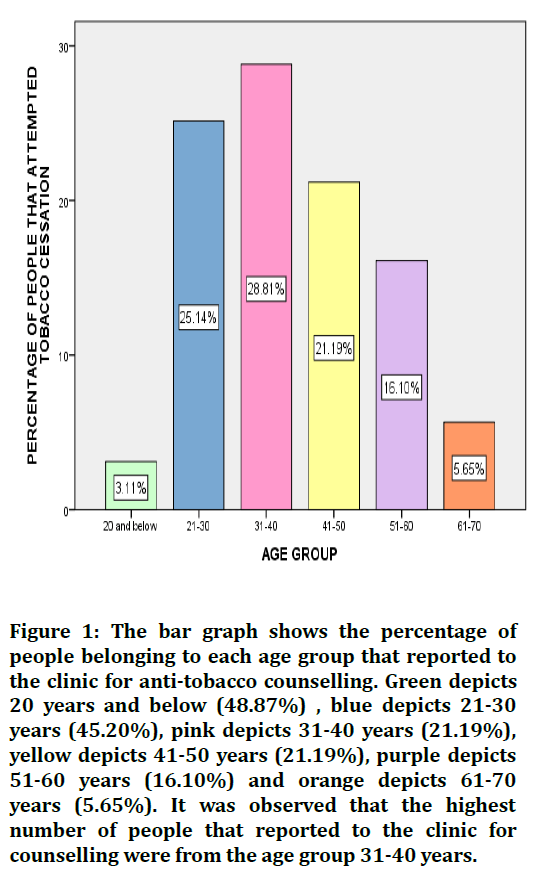
Figure 1. The bar graph shows the percentage of people belonging to each age group that reported to the clinic for anti-tobacco counselling. Green depicts 20 years and below (48.87%) , blue depicts 21-30 years (45.20%), pink depicts 31-40 years (21.19%), yellow depicts 41-50 years (21.19%), purple depicts 51-60 years (16.10%) and orange depicts 61-70 years (5.65%). It was observed that the highest number of people that reported to the clinic for counselling were from the age group 31-40 years.
We also found that 97.74% of the patients that reported to the clinic were males and only 2.26% of them were females (Figure 2).
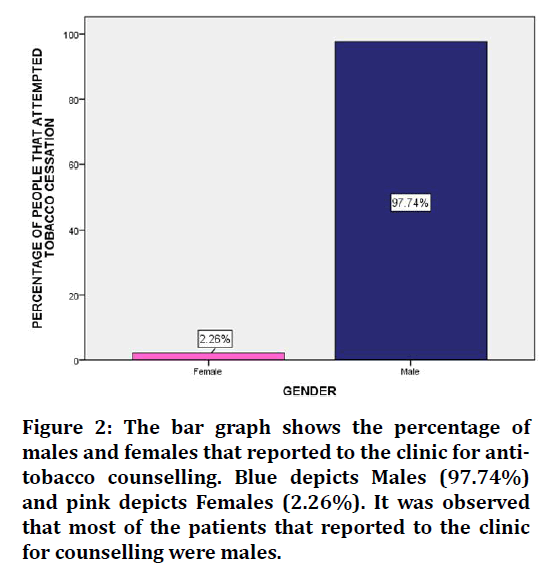
Figure 2. The bar graph shows the percentage of males and females that reported to the clinic for antitobacco counselling. Blue depicts Males (97.74%) and pink depicts Females (2.26%). It was observed that most of the patients that reported to the clinic for counselling were males.
On analyzing the number of attempts made by the patients on quitting tobacco, we found that 48.87% of the patients had only attempted once, 45.20% attempted twice and 5.93% of the patients had attempted more than twice (Figure 3).
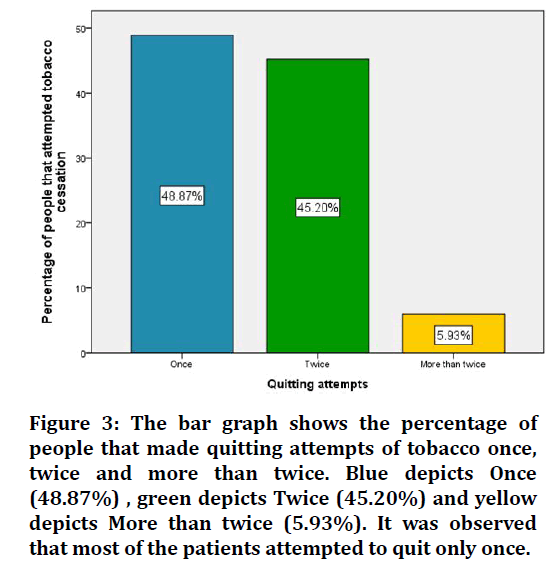
Figure 3. The bar graph shows the percentage of people that made quitting attempts of tobacco once, twice and more than twice. Blue depicts Once (48.87%) , green depicts Twice (45.20%) and yellow depicts More than twice (5.93%). It was observed that most of the patients attempted to quit only once.
The graphs also showed that, the longest period of tobacco abstinence among the patients was found to be Less than 6 months (44.07%) followed by Less than a year (23.73%), more than a year (18.08%) and Less than a month (14.12%) (Figure 4).
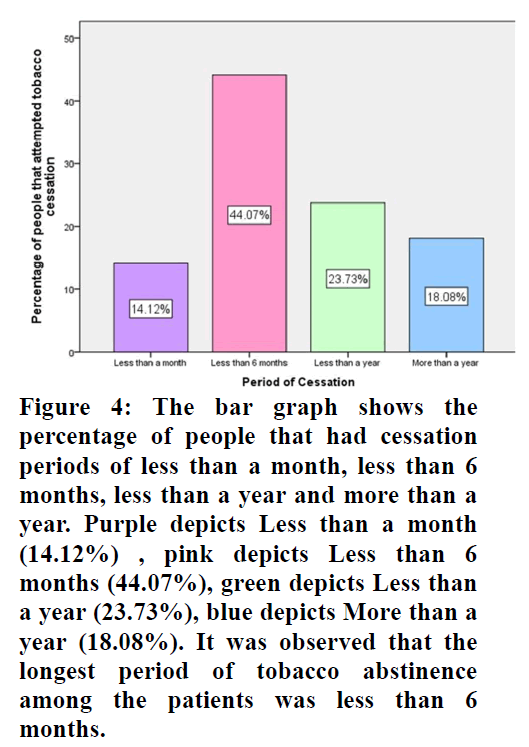
Figure 4. The bar graph shows the percentage of people that had cessation periods of less than a month, less than 6 months, less than a year and more than a year. Purple depicts Less than a month (14.12%) , pink depicts Less than 6 months (44.07%), green depicts Less than a year (23.73%), blue depicts More than a year (18.08%). It was observed that the longest period of tobacco abstinence among the patients was less than 6 months.
Finally when asked what the barriers they faced during tobacco cessation were, most of them said Addiction (39.55%) followed by Stress (29.38%), Withdrawal symptoms (9.32%) Peer influence (8.19%), Weak selfcontrol (7.63%) and Depression (5.93%) (Figure 5).
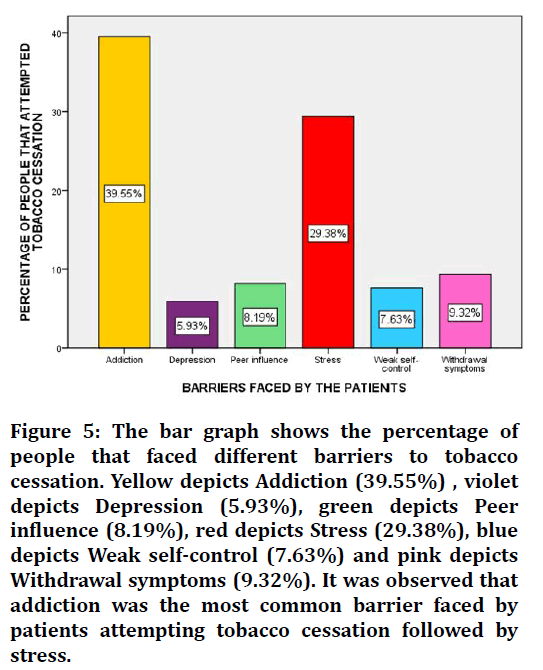
Figure 5. The bar graph shows the percentage of people that faced different barriers to tobacco cessation. Yellow depicts Addiction (39.55%) , violet depicts Depression (5.93%), green depicts Peer influence (8.19%), red depicts Stress (29.38%), blue depicts Weak self-control (7.63%) and pink depicts Withdrawal symptoms (9.32%). It was observed that addiction was the most common barrier faced by patients attempting tobacco cessation followed by stress.
Discussion
To the best of our knowledge, this is a study assessing the attempts made by patients willing to quit tobacco use and the various barriers faced by them in the process. In this developing country it was found that the age group 31-40 years had the highest number of people attempting to quit tobacco (28.81%) and the next highest number was seen in the age group 21-30 years (Figure 1). Another study conducted in 2020 stated that current cigarette smoking was highest among people aged 25–44 years and 45–64 years [13]. This can be attributed to the fact that middle aged people who have work stress are more likely to develop a habit of smoking for stress relief. Young adults tend to be drawn to smoking due to peer influence.
We also found that 97.74% of the patients that reported to the clinic were males and only 2.26% of them were females (Figure 2). A study conducted in 2013 revealed that there are approximately 1 billion tobacco smokers worldwide that amounts to approximately 30% of men and 7% of women [14,15]. Generally, men tend to use tobacco products at higher rates than women. This difference may be due to a combination of physiological, cultural and behavioral factors.
On analyzing the number of attempts made by the patients on quitting tobacco, we found that 48.87% of the patients had only attempted once, 45.20% attempted twice and 5.93% of the patients had attempted more than twice (Figure 3). Number of attempts needed to successfully quit tobacco is generally higher due to relapse. Some may quit in early attempts and some will need repeated attempts. The guidance is required to keep the patients motivated to follow through with subsequent attempts.
We also found that, the longest period of tobacco abstinence among the patients was found to be Less than 6 months (44.07%) followed by Less than a year (23.73%), more than a year (18.08%) and Less than a month (14.12%) (Figure 4). A study conducted on the period of cessation for patients attempting to quit tobacco showed that approximately 5% of unaided quit attempts lasted for at least 6 months. Relapse after this point is estimated to be approximately 50% [3,16]. Usually the patients are determined to follow through with the quitting attempt in the first few months. However gradually the patients give in to their addiction resulting in relapse. Thus the average period of cessation for most of the patients approximated to about 6 months.
Finally when asked what the barriers they faced during tobacco cessation were, most of them said Addiction (39.55%) followed by Stress (29.38%), Withdrawal symptoms (9.32%) Peer influence (8.19%), Weak selfcontrol (7.63%) and Depression (5.93%) (Figure 5). Results from another study showed that the most common barriers were anxiety (82%), tension/ irritability (76%), and concerns about the ability to maintain sobriety from their primary substance of abuse (64%) [17]. The nicotine present in tobacco is an addictive substance that causes a ‘good feeling’ by triggering certain receptors in the brain. Patients find it difficult to give this up after developing dependence to it. They also claim that it helps relieve stress from work, personal life, etc. In some cases sudden quitting of tobacco even causes symptoms like tremors, headaches, irritability, etc.
Conclusion
Within the limits of the study we found that the highest number of people that reported to the clinic for antitobacco counselling was from the age group 31-40 years. Very few patients had made more than two attempts to quit tobacco. The longest period of tobacco abstinence among the patients was found to be less than 6 months. Addiction and Stress were the two main barriers faced by patients attempting tobacco cessation.
Acknowledgement
We would like to thank Saveetha Dental College for providing us with this opportunity to conduct a study on Quitting attempts and Barriers faced by patients for tobacco cessation. We would also like to thank our reviewers for their contributions.
Conflicts of Interest
Nil.
Source of Funding
The present study is supported by
• Saveetha Institute of Medical and Technical Sciences, Saveetha Dental College and Hospitals, Saveetha University, India.
• Al Shams Energies Private Ltd.
References
- https://apps.who.int/iris/handle/10665/43818
- East KA, Reid JL, Rynard VL, et al. Trends and patterns of tobacco and nicotine product use among youth in Canada, England, and the United States from 2017 to 2019. J Adolesc Health 2021; 69:447-456.
- Hughes JR, Keely J, Naud S. Shape of the relapse curve and long-term abstinence among untreated smokers. Addiction 2004; 99:29–38.
- Melnyk KA. Barriers: A critical review of recent literature. Nurs Res 1988; 37:196–201.
- Theobald W, Smith SS, Fiore M. Insights: Smoking in Wisconsin. University of Wisconsin Medical School: UW Center for Tobacco Research and Intervention 2002.
- Guirguis AB, Ray SM, Zingone MM, et al. Smoking cessation: Barriers to success and readiness to change. Tenn Med 2010; 103:45–49.
- Orleans CT, Jepson C, Resch N, et al. Quitting motives and barriers among older smokers. The 1986 adult use of tobacco survey revisited. Cancer 1994; 74:2055–2061.
- Benowitz NL. Nicotine addiction. N Engl J Med 2010; 362:2295–2303.
- http://www.das.state.ct.us/rfpdoc/dph/results/2009-0916.pdf
- Papadakis S, Gharib M, Hambleton J, et al. Delivering evidence-based smoking cessation treatment in primary care practice: Experience of ontario family health teams. Can Fam Physician 2014; 60:e362–71.
- Chaiton M, Diemert L, Cohen JE, et al. Estimating the number of quit attempts it takes to quit smoking successfully in a longitudinal cohort of smokers. Br Med J 2016; e011045.
- Benowitz NL. Pharmacology of nicotine: Addiction, smoking-induced disease, and therapeutics. Annu Rev Pharmacol Toxicol 2009; 49:57–71.
- Cornelius ME, Wang TW, Jamal A, et al. Tobacco product use among adults-United States, 2019. Morb Mortal Wkly Rep 2020; 69:1736–1742.
- Eriksen M, Mackay J, Ross H. The tobacco Atlas. Atlanta, GA: American Cancer Society; New York, NY: World Lung Foundation; 2012. 2013.
- Gowing LR, Ali RL, Allsop S, et al. Global statistics on addictive behaviours: 2014 status report. Addiction 2015; 110:904–919.
- Stapleton JA, West R. A direct method and ICER tables for the estimation of the cost-effectiveness of smoking cessation interventions in general populations: Application to a new cytisine trial and other examples. Nicotine Tob Res 2012; 14:463–71.
- West R. The multiple facets of cigarette addiction and what they mean for encouraging and helping smokers to stop. COPD 2009; 6:277–283.
Indexed at, Google Scholar, Cross Ref
Indexed at, Google Scholar, Cross Ref
Indexed at, Google Scholar, Cross Ref
Indexed at, Google Scholar, Cross Ref
Indexed at, Google Scholar, Cross Ref
Indexed at, Google Scholar, Cross Ref
Indexed at, Google Scholar, Cross Ref
Indexed at, Google Scholar, Cross Ref
Indexed at, Google Scholar, Cross Ref
Indexed at, Google Scholar, Cross Ref
Author Info
Farhat Yaasmeen Sadique Basha, Sri Sakthi* and Sudharrshiny S
Department of Public Health Dentistry, Saveetha Institute of Medical and Technical Sciences Saveetha University, Chennai, IndiaReceived: 07-Jan-2022, Manuscript No. JRMDS-22-51337; , Pre QC No. JRMDS-22-51337 (PQ); Editor assigned: 10-Jan-2022, Pre QC No. JRMDS-22-51337 (PQ); Reviewed: 24-Jan-2022, QC No. QC No. JRMDS-22-51337; Revised: 27-Jan-2022, Manuscript No. JRMDS-22-51337 (R); Published: 03-Feb-2022
